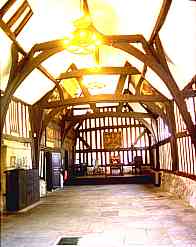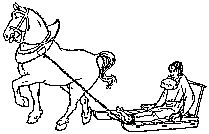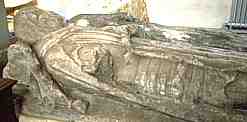
Parliament



If you are looking at this page without frames, there is more information about medieval writing to be found by going to the home page (framed) or the site map (no frames).
| Law and Administration (4) | ||||
| Whatever copies of documents were kept by the English royal chancery up until 1199, there has been no systematic preservation of them. But at that time the process was instigated of recording copies of chancery documents on long rolls made from sections of parchment sewn end to end to make strips many metres long. Nobody seems to know for sure why they chose this awkward format, rather than transcribing them into a codex, as was evidently done with such records in continental Europe. I have a theory that it was a bit like a medieval CD-ROM. Once it was all finalised and stitched together, it would have been impossible to lose, extract and alter, or otherwise tamper with any individual document. This is an untested and untestable hypothesis. (See Clanchy 1993 also Elton 1969 also Bagley 1972) | ||||
| Once the process of recording in this way started, the material proliferated and from the 13th century there were various classes of rolls which recorded different types of information, including copies of assorted documents which emanated from the chancery and information which was gathered into the chancery about such matters as the financial state of feudal tenants. The other royal secretariats, the privy seal and the signet, did not keep rolls, but information which passed between the offices is preserved in various warrants. From about 1340 the chancery also kept records of Parliament. The National Archives in London is the custodian of this material and it will keep generations of historians busy for centuries. |
 |
|||
|
Parliament |
||||
| During the 13th century the process of administration in the literate mode accelerated. It disseminated from the centre of government to the towns and to the rural manors. Written documents were required for all manner of transactions at all social levels. Rights, privileges and transactions enacted between individuals at the modest end of the social spectrum had to be ratified by the written word. The growth of towns and the movements of craftsmen, traders, farmers to market, not to mention thieves and vagabonds caused a proliferation of identifying and validating documentation. The multiple layers of the legal process required much recording. | ||||
 |
||||
| Late medieval guildhalls like this one in Leicester represent the development of literate bureaucracy at the town level. | ||||
| This does not mean that the entire populace had become fully literate. There were, no doubt, many people clutching and exchanging their bits of parchment who had to have the content explained by the scribes and officials who produced them. Then they might have to trot around to the parish priest to have it explained again. In their own minds they were perhaps still carrying out their agreements and transactions by oral agreement, although it is dangerous to speculate on what might have been going on in someone's mind 700 years ago. | ||||
| However, more people were working in literate industries. It was not just the intellectuals of the church who knew how to write. Armies of scribes, scriveners and notaries formed whole new classes of penpushers. Local officials needed more than a knowing stare and a good memory for faces as written recording became part of their duties. Managers of manors and farms added writing skills to their centuries of oral lore about animals, plants and the sun, moon and stars. |
 |
|||
| Purveyor of short weight loaves being taken to the pillory, a victim of literate bureaucracy at the town level. | ||||
| For some scribes, their literacy may have been relatively limited in terms of the exacting standards which we apply today. We regard someone as inadequately literate who cannot pick up a previously unknown text, read it rapidly and silently for sense and give us a quick summary of the contents. Many legal documents are formulaic. Even the fact that many were in Latin need not imply great linguistic skill, just a memory for some standard forms and care and attention in the tricky bits. The same phrases and format would have been copied and recopied by scribes with excellent penmanship who had repeated them so many times that they knew them as well as the local priest knew his mass. It was probably as boring as digging up turnips, but cleaner and warmer. | ||||
| Other areas, such as the law, required a high degree of literacy skills. There were people employed to listen to court cases, take notes and write them up into summaries, in Latin. Notaries were professionals who could draft, as well as simply scribe, legal documents. The legal profession was not drawn from the clergy, the traditional practitioners of genuine literacy, but was a group of lay professionals. |  |
|||
| Alabaster funerary effigy of a judge in the parish church of Eastrington, Yorkshire. | ||||
| The battered effigy above shows the judge in his judicial coif, or cap, and robe over his full suit of armour. He did not actually get about like this, but it symbolises his roles both as judge and as knight. It also indicates his status as a member of the laity, as those who were clericus were depicted wearing and carrying the significata of their clerical status. | ||||
|
|
||||
If you are looking at this page without frames, there is more information about medieval writing to be found by going to the home page (framed) or the site map (no frames). |
||||